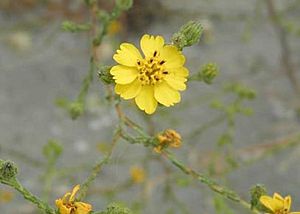Deinandra conjugens facts for kids
The Otay tarplant (Deinandra conjugens) is a very rare flowering plant. It's also known as Otay tarweed. This plant belongs to the aster family, which includes sunflowers and daisies. You can find it in a small area of northern Baja California, Mexico. Its range also extends north into San Diego County, California, in the United States. A few plants have even been found near Cayucos, California.
This special plant is in danger because its home is being destroyed or damaged. Because of this, the U.S. government listed it as a threatened species in 1998.
Quick facts for kids Deinandra conjugens |
|
|---|---|
 |
|
| Conservation status | |
| Scientific classification | |
| Kingdom: | |
| (unranked): | |
| (unranked): | |
| (unranked): | |
| Order: | |
| Family: | |
| Subfamily: |
Asteroideae
|
| Tribe: | |
| Genus: | |
| Species: |
D. conjugens
|
| Binomial name | |
| Deinandra conjugens (D.D.Keck) B.G.Baldw.
|
|
| Synonyms | |
|
Hemizonia conjugens D.D.Keck |
|
Contents
What Does the Otay Tarplant Look Like?
The Otay tarplant is an annual herb. This means it lives for only one growing season. It can grow up to about 1.5 feet (0.5 meters) tall. Its stem is solid and covered with tiny bristles. It also has small glands that look like dots.
The leaves near the bottom of the plant are hairy. They can be lobed or have small teeth along their edges. These leaves can grow up to about 1.8 inches (4.5 centimeters) long.
Flowers and Seeds
The plant's inflorescence (flower cluster) has one or more flower heads. Sometimes, many heads grow close together in clusters. The underside of each head is covered in special leaves called phyllaries. These phyllaries have many glands.
Each flower head has 7 to 10 yellow ray florets. These are the petal-like parts, and they are usually less than 6 millimeters long. Most ray florets have three tiny lobes at their tips. The center of the head is full of yellow disc florets. These disc florets have black, dark purple, or red anthers at their tips. Bees often help to pollinate these flowers.
The fruit of the plant is a type of seed called an achene. The achenes from the disc florets have a pappus (a tuft of white scales). These disc achenes usually germinate (sprout) faster than the achenes from the ray florets. Many of these seeds fall into the ground, forming a "seed bank" in the soil.
Where Does the Otay Tarplant Live?
The Otay tarplant grows in clay soils. It can be found in different types of natural areas. These include grasslands and maritime (near the sea) and inland coastal sage scrub habitats.
This plant can handle some changes in its environment. Small amounts of grazing by animals and activities like mowing roadsides can even help it.
Most of the known Otay tarplant populations are in San Diego County in the United States. Many are in the southern part of the county, in places like Otay Mesa and Proctor Valley. The city of San Diego has a plan to protect this plant and keeps an eye on it. There are about 34 to 37 groups of these plants left. Sadly, some known groups are thought to have disappeared since the plant was listed as threatened.
Protecting the Otay Tarplant
The area where the Otay tarplant lives is greatly affected by new buildings and other human activities. Its habitat is now broken up into smaller pieces. About 70% of the plant's original home has been destroyed.
Good news is that much of the land once threatened by development is now protected. It has become part of several nature reserves. Many areas are protected by a San Diego county ordinance. The San Diego National Wildlife Refuge even created a special Otay Tarplant Preserve. Also, Caltrans set aside land for the plant near a busy highway. While many California populations are now safe, others are still in danger. We don't know much about the plant's status in Mexico.
Threats to the Plant
Besides losing its home, the Otay tarplant faces other problems. Introduced weeds have moved into its habitat. These include brome grasses, wild oats, and ryegrass. These invasive plants can outcompete the native tarplant.
Other issues include Off-road vehicles being used on some land where the plant grows. Also, trash dumping has happened in some areas. The upkeep of rural roads that lead to utility stations can also affect the land. Many plant populations are near the international border. Activities in this area can impact the plant's habitat.


